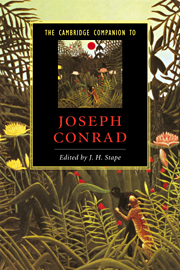4 - Lord Jim
Published online by Cambridge University Press: 28 May 2006
Summary
Any reading of Lord Jim that aspires to be comprehensive must come to terms with the novel's title-character. To borrow Emerson's words, he incarnates the 'plain old Adam, the simple genuine self against the whole world', a notoriously unequal struggle with a foreordained outcome. Conrad's earlier Malay novels, the 'Lingard Trilogy' of Almayer's Folly, An Outcast of the Islands, and the unfinished 'The Rescuer', similarly focus on individuals living in exile from their culture and blindly in pursuit of an unhappy fate. But while the early novels describe the failure of unsympathetic protagonists (and Lingard, too, in his naivete and braggadocio is distanced from the reader), Lord Jim is famously ambiguous. A technical tour de force, it painstakingly dissects and then reassembles the activities and consciousness of a young man, who in his failings and virtues appears to be 'one of us'. Because of a multiplicity of virtuoso narrative techniques that sometimes alienate the reader, Jim, however, is both at the novel's centre and on its periphery. He is thus always present either as a massively constructed figure in the foreground, in the manner of the memorable characters of Dickens or George Eliot, or as a hovering evoked presence in the background.
- Type
- Chapter
- Information
- The Cambridge Companion to Joseph Conrad , pp. 63 - 80Publisher: Cambridge University PressPrint publication year: 1996
- 3
- Cited by

